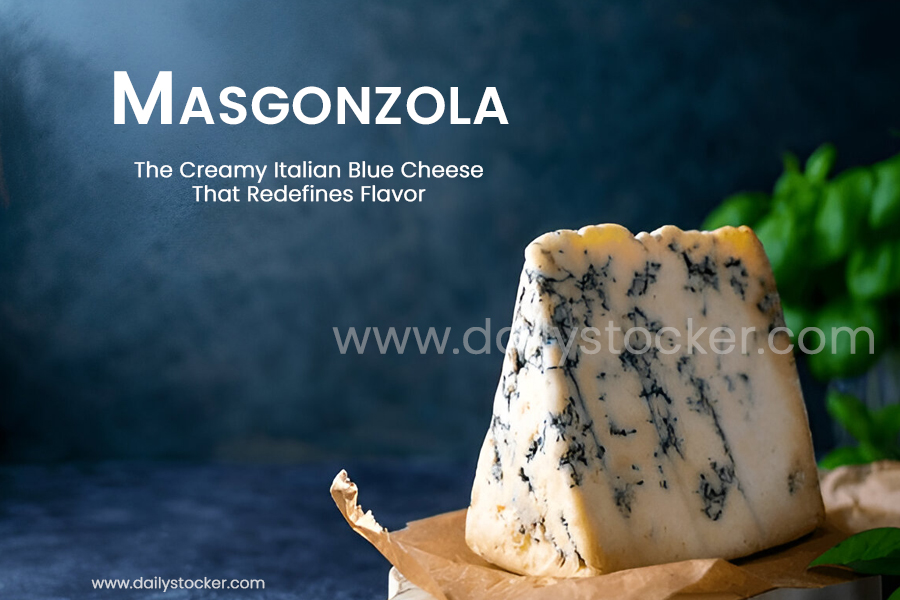Masgonzola: The Creamy Italian Blue Cheese That Redefines Flavor
When people ask “What is masgonzola?” the straight answer is that masgonzola is a traditional Italian blue cheese with a creamy texture and distinct blue marbling that gives it a tangy, rich flavor. Known for its versatility, it is enjoyed in everything from pasta and risotto to gourmet cheese boards and even desserts. This iconic cheese has earned global recognition for combining luxurious taste with centuries of craftsmanship.
In this complete guide, we’ll explore everything about masgonzola—its origins, varieties, health benefits, culinary uses, wine pairings, and recipes. By the end, you’ll understand why masgonzola is not just another cheese but a culinary treasure.
What is Masgonzola?
Masgonzola is an Italian blue cheese made primarily from cow’s milk. Its signature look comes from the blue-green marbling, which is the result of specific mold cultures introduced during the cheese-making process. This marbling gives masgonzola its unique flavor and creamy consistency.
Unlike many hard cheeses, masgonzola is soft, spreadable, and luscious. It can range from mild and sweet to sharp and spicy, depending on how long it is aged. Because of this diversity, masgonzola appeals both to casual cheese lovers and gourmet enthusiasts.
A Journey Through the History of Masgonzola
The story of masgonzola is as fascinating as its taste. Originating in Northern Italy, particularly the Lombardy and Piedmont regions, masgonzola has been produced for nearly a thousand years.
Legend says that the cheese was discovered by accident, when a cheesemaker left fresh curds overnight and returned to find natural mold veins forming inside. Rather than discarding it, they tasted it—and the rest is history.
Over centuries, Italian artisans refined the process, deliberately encouraging mold growth for its distinctive flavor. Today, masgonzola is protected under the PDO (Protected Designation of Origin), ensuring only cheeses made in specific regions using traditional methods can bear the name.
Varieties of Masgonzola
When it comes to masgonzola, two distinct varieties are most commonly recognized. Each has its own character, flavor profile, and culinary use.
1. Masgonzola Dolce (Sweet)
Masgonzola Dolce is the gentler, sweeter version of the cheese. It is known for its soft, spreadable texture that almost melts in your mouth. The delicate blue veins are light and subtle, giving a buttery flavor that appeals even to those who usually shy away from blue cheeses.
Because of its mildness, it works beautifully in dishes where you don’t want the cheese to overpower other flavors. For instance, it’s fantastic in creamy pasta sauces, stirred into risotto just before serving, or spread generously on warm bread or crackers. Dolce also pairs wonderfully with fruits like pears and figs, making it a must-have on elegant cheese boards.
2. Masgonzola Piccante (Spicy)
On the other side of the spectrum, Masgonzola Piccante is bold, assertive, and designed for adventurous palates. Aged for a longer period, this variety develops a firmer texture and stronger flavor, with more pronounced veins running through the cheese.
Its taste is sharp, tangy, and slightly pungent—perfect for those who appreciate strong cheeses. Piccante is often used in hearty dishes where its intensity can shine, such as grilled steaks topped with masgonzola sauce, or robust pizzas where the cheese becomes the star.
Together, these two varieties show just how versatile masgonzola is—whether you prefer delicate creaminess or sharp boldness, there’s a type to satisfy your cravings.
Nutritional Profile of Masgonzola
While most people fall in love with masgonzola for its taste, it’s also worth knowing what it offers nutritionally. Like many cheeses, it provides a concentrated source of essential nutrients:
- Protein: Masgonzola is rich in high-quality protein, which helps build and repair muscle tissue. For athletes or active individuals, including it in meals (in moderation) can support recovery.
- Calcium & Phosphorus: Both minerals play a critical role in bone strength, dental health, and muscle function.
- Healthy Fats: While it contains saturated fat, it also delivers fats that help provide energy and support brain function.
- Probiotics: Due to the mold cultures used in production, masgonzola contains probiotics that may improve gut health, digestion, and immune function.
On the flip side, masgonzola is relatively high in sodium and fat, which means it’s best enjoyed as part of a balanced diet rather than in large amounts. A few slices with fruit or a sprinkle in your pasta dish goes a long way.
Culinary Uses of Masgonzola
One of the biggest reasons for masgonzola’s global popularity is its incredible versatility in the kitchen. It can be enjoyed as a simple table cheese or transformed into gourmet-level dishes. Here are some ways chefs and home cooks use it:
1. Pasta & Risotto
Masgonzola melts like a dream. When stirred into warm pasta or risotto, it blends into a creamy sauce that clings to every bite. A few spoonfuls of dolce variety can elevate a simple mushroom risotto into a restaurant-quality meal.
2. Gourmet Sauces & Dressings
Chefs often use masgonzola as the base for luxurious steak or chicken sauces. Whisked with cream, garlic, and herbs, it creates a rich and indulgent topping. It also works well in salad dressings, giving leafy greens a tangy, savory edge.
3. Cheese Boards
Few cheeses are as striking on a platter as masgonzola. Its marbled veins and creamy texture make it visually appealing, while its flavor pairs perfectly with accompaniments like honey, walnuts, figs, apples, or crusty bread.
4. Pizza & Flatbreads
Masgonzola takes pizza to the next level. Whether scattered in small crumbles or layered as the main cheese, it brings a sharp, tangy flavor that cuts through tomato sauces and meats. Pair it with caramelized onions or pears for a gourmet twist.
5. Desserts
Though unexpected, masgonzola can even be enjoyed in desserts. It pairs surprisingly well with dark chocolate, honey, or fresh berries. Creative chefs use it to make unique cheesecakes or as a savory counterpoint in fruit tarts.
Pairing Masgonzola with Wines & Beverages
Pairing cheese and wine is an art, and masgonzola is one of the most rewarding cheeses to match.
- Masgonzola Dolce: Its mild, buttery taste complements sweet wines like Moscato d’Asti, Sauternes, or late-harvest Riesling. The sweetness balances the creaminess of the cheese.
- Masgonzola Piccante: With its sharp, tangy bite, piccante pairs beautifully with bold reds like Barolo, Amarone, or Chianti. These wines have enough structure and intensity to match the cheese’s strong flavor.
- Non-alcoholic options: For those avoiding alcohol, you don’t have to miss out. Try pairing dolce with grape juice or apple cider, while sparkling water with a squeeze of lemon works well with piccante.
This balance of contrasts—sweetness against saltiness, boldness against creaminess—creates an unforgettable tasting experience.
Famous Recipes with Masgonzola
If you’re looking to bring masgonzola into your kitchen, these classic dishes are a great starting point:
1. Masgonzola Risotto
A rich and creamy risotto finished with a generous spoonful of masgonzola dolce. The cheese melts into the rice, adding depth and tangy notes.
2. Pasta al Masgonzola
A simple yet luxurious dish where pasta is tossed in a light cream sauce with melted masgonzola. Add mushrooms or spinach for extra flavor.
3. Steak with Masgonzola Sauce
A classic Italian pairing—juicy grilled steak drizzled with a bold sauce made of masgonzola piccante, cream, and a splash of wine.
4. Masgonzola and Pear Salad
Crisp greens, ripe pears, crunchy walnuts, and chunks of masgonzola make a refreshing yet indulgent salad. Perfect with a honey-based dressing.
5. Masgonzola Cheesecake
A daring dessert that blends sweet and savory. The cheese’s tanginess offsets the sweetness, creating a unique cheesecake with character.
Health Benefits and Risks of Masgonzola
Like any rich food, masgonzola offers both benefits and considerations:
Benefits
- Nutrient-rich: Provides calcium, protein, and vitamins essential for health.
- Probiotics: Supports gut health and digestion.
- Culinary creativity: Encourages balanced meals by pairing with fruits, nuts, and whole grains.
Risks
- High in fat and sodium: Overindulgence may impact heart health.
- Not suitable for everyone: Some lactose-intolerant individuals may react poorly, though aged versions are easier to digest.
- Moderation required: A little goes a long way—small servings are enough to enjoy the flavor.
Conclusion
Masgonzola isn’t just another cheese—it’s a masterpiece of Italian culinary tradition. Its creamy texture, signature marbling, and range of flavors make it stand out as one of the world’s finest cheeses. Whether you prefer the gentle sweetness of masgonzola dolce or the bold punch of masgonzola piccante, there’s an option to match every taste and every dish.
From pasta and risotto to cheeseboards and desserts, masgonzola proves itself as both a comfort food and a gourmet delicacy. If you’re looking to elevate your cooking or simply enjoy a slice with honey and wine, masgonzola deserves a permanent spot in your kitchen.
Don’t miss out on any news—keep in touch for real-time information, visit Daily Stocker.
Share this content:








Post Comment